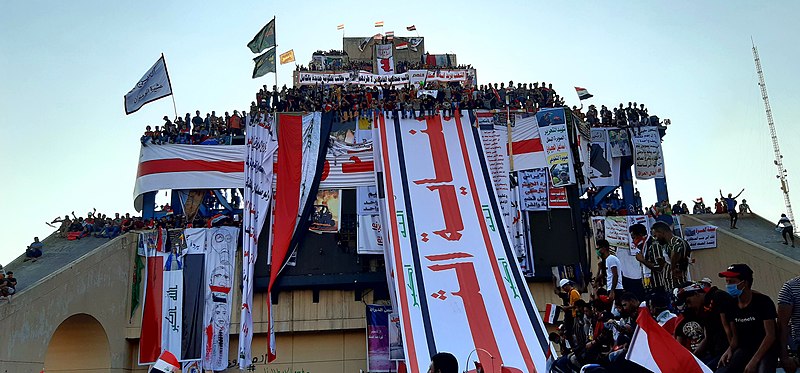Almost four months after the start of the anti-government protests in Baghdad, what is left is not only an amalgamation of rebellion and government retaliation but also an assortment of art, including paintings, poems, plays and literature.
The demonstrations started on October 1st, 2019 and are ongoing. They were born from the people’s resentment and their anger at the endemic corruption, external intervention, dismal civil society and high unemployment. Students and citizens under the age of thirty are the backbone of the protest and represent a cross-section of society that wants to reconstruct the post-2003 political system. The system was founded on deep sectarian divides as a result of the US-led invasion of Iraq at the time.
Iraq has been under a deeply sectarian political system for the past decade involving Sunni Arabs failing at their attempt to topple the state. Kurds were also largely against the Shia-led government. The seriousness of the current rebellion can be derived from the fact that it was areas of Shia-led political power which gave rise to the protests. The sectarian divisions have not disappeared, however, their importance has severely diminished. The artistic movement has given rise to a community that stands together and supports each other despite their differences.
Protests have led to a vast number of protesters being killed and wounded. In such times of heartbreak, art has risen to the forefront of Iraqi expression. Baghdad, along with the Shia-majority in the south, has been at the centre of anti-government demonstrations. The Tahrir square in Baghdad has become a rare space of expression in an environment where conservative parties, legislative and influential politicians have tried to suppress criticism. Walls are covered with intricate paintings and graffiti while tents with banners advertising “Revolution Theatre” have been set up to display films and documentaries of revolution in Syria, Egypt and Ukraine.
But what can be considered the most significant contribution of this movement is perhaps the “Turkish Restaurant” building that was taken over by protestors at the kickoff of the protests.It is a 15-floor structure that was abandoned a decade ago, a fortress that symbolises the dissent of the Iraqis who oppose the nation’s leadership. Wrapped in banners and posters with messages directed towards the state, the military and the world, the building looks like a box bursting at the seams with the dissenting voice of the country demanding to be heard. The first five stories are glorified canvases covered in murals at the centre of a major art movement that has sprung up in Baghdad as a response to the government’s violent reaction to the protests. Paintings, professional and amateur, have turned every free space into a declaration of defiance.
Aside from artists, this culture of rebellion includes those who have taken on the role of unofficial tour guides communicating their peaceful yet poignant journey to rebellion.
Where has this art come from? Baghdad is a city shaped by its rich culture, however, years of oppression and poverty have suppressed the vivid colours of the city. The restriction on the city was defied when the protest first started, and now that it has claimed back its voice, it refuses to lose it. The anger and resentment against the state for not hearing the concerns of the people have created a fire so strong that it has bonded together those from different walks of life in a society that was once divided by religious sects and class distinctions encouraged by the government.
While it has not suddenly become a utopia, a sense of comradery and community has certainly immerged.
At the centre of rebellion, the path leading to the city’s square has been covered in the blood of the slain protesters, memorializing them forever. The death count of the protest is estimated to be over 500. The sculptures, paintings and shrines to the martyred protesters are a kind of political art Iraqi’s have rarely seen, a nation that has created art for centuries. They are now growing aware of the extent and influence of their own creative power. An awareness that is turning a protest into a revolution.
The muses and styles of the murals show the effect of the internet on the community built around this movement. The influence of the younger generation as a foundation of the movement is identifiable by the artistic subjects chosen in various murals. Rosie the Riveter has an Iraqi flag painted on her cheek, Vincent Van Gogh’s “starry night” has the Turkish restaurant building in place of the Cypress tree. Other muses include comic book characters enshrined in the Iraqi flag to represent the uniform of the protesters.
But the strongest sentiment that begs to be heard in the wake of this movement is the Iraqi voice dissenting from the world view of their culture as based in war and blood. Instead, they reclaim their history as artists. They define themselves as intellectuals who are painters and poets, musicians and sculptors and above all else — citizens who demand a better future.
Edited by Zach Beresin
Photo credits: “The Turkish restaurant, Iraqi protests 2019” by Hassan Majed. Published 1st of November, 2019. This work was sourced under a Attribution-ShareAlike 4.0 International license. No changes were made.
Mehak Balwani is in her third year at McGill University, currently pursuing a B.A. in International Development and English Literature.

